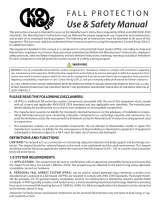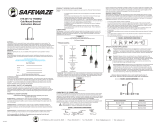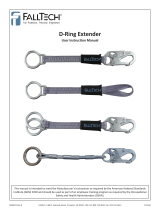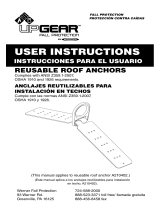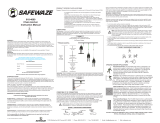
9
1.0 PRODUCT APPLICATION
1.1 PURPOSE: Anchorage Connectors are designed to provide anchorage connection points for Fall Arrest
1
, Fall Restraint
2
,
Work Positioning
3
, or Rescue
4
systems.
;
Do not connect Lifting Equipment to the Anchorage Connector.
1.2 STANDARDS: Your Anchorage Connector conforms to the national or regional standard(s) identied on the front cover
of these instructions. If this product is resold outside the original country of destination, the re-seller must provide these
instructions in the language of the country in which the product will be used.
1.3 SUPERVISION: Use of this equipment must be supervised by a Competent Person
5
.
1.4 TRAINING: This equipment must be installed and used by persons trained in its correct application. This manual is to
be used as part of an employee training program as required by ANSI and OSHA, and/or regional regulations. It is the
responsibility of the users and installers of this equipment to ensure they are familiar with these instructions, trained in
the correct care and use of this equipment, and are aware of the operating characteristics, application limitations, and
consequences of improper use of this equipment.
1.5 RESCUE PLAN: When using this equipment and connecting subsystem(s), the employer must have a rescue plan and
the means at hand to implement and communicate that plan to users, authorized persons
6
, and rescuers
7
. A trained, on-
site rescue team is recommended. Team members should be provided with the equipment and techniques to perform a
successful rescue. Training should be provided on a periodic basis to ensure rescuer prociency.
1.6 INSPECTION FREQUENCY:
The Anchorage Connector shall be inspected by the user before each use and, additionally,
by a competent person other than the user at intervals of no longer than one year.
8
Inspection procedures are described in
the “Inspection and Maintenance Log”. Results of each Competent Person inspection should be recorded on copies of the
“Inspection and Maintenance Log”.
1.7 AFTER A FALL: If the Anchorage Connector is subjected to the forces of arresting a fall, it must be removed from service
immediately, clearly marked “DO NOT USE”, and then either destroyed or forwarded to 3M for replacement or repair.
2.0 SYSTEM REQUIREMENTS
2.1 ANCHORAGE: Anchorage structure requirements vary with the system application and whether it is a certied
anchorage
9
or non-certied anchorage
10
. The structure to which a fall arrest, restraint, positioning, or rescue system is
attached must sustain static loads applied in the directions permitted as shown in the following table. Anchorage Strength
requirements, along with system applications, are specied below, unless noted or dened otherwise in Table 1:
Fall Protection System Certied Anchorage
9
Non-Certied Anchorage
10
Dened by
Fall Arrest 2 times maximum arresting force 5,000 lbs (22.2 kN) OSHA, ANSI
Restraint/Travel Restraint 2 times foreseeable force
1,000 lbs (4.4 kN) per ANSI
5,000 lbs (22.2 kN) per OSHA
OSHA, ANSI
Work Positioning 2 times foreseeable force 3,000 lbs (13.3 kN) OSHA, ANSI
Rescue 5 times applied load 3,000 lbs (13.3 kN) ANSI
When more than one system is attached to an anchorage, the strengths stated above must be multiplied by the number
of systems attached to the anchorage. See ANSI Z359.2 for more information.
2.2 PERSONAL FALL ARREST SYSTEM: Figure 1 illustrates the application of this Anchorage Connector. Personal Fall
Arrest Systems (PFAS) used with the system must meet applicable Fall Protection standards, codes, and requirements.
The PFAS must incorporate a Full Body Harness and limit Arresting Force to the following values:
Maximum Arresting Force Free Fall
PFAS with Shock Absorbing Lanyard 1800 lbs (8 kN)
Refer to the instruction(s) included with your
Lanyard or SRD for Free Fall limitations.
PFAS with Self Retracting Device (SRD) 1800 lbs (8 kN)
2.3 FALL PATH AND SRD LOCKING SPEED: A clear path is required to assure positive locking of an SRD. Situations which
do not allow for an unobstructed fall path should be avoided. Working in confined or cramped spaces may not allow the
body to reach sufficient speed to cause the SRD to lock if a fall occurs. Working on slowly shifting material, such as sand
or grain, may not allow enough speed buildup to cause the SRD to lock.
1 Fall Arrest System: A collection of Fall Protection Equipment congured to arrest a free fall. Protects the user in the event of a fall. Free fall is permitted up to
the limits allowed by the connecting device (either an Energy Absorbing Lanyard or Self-Retracting Device (SRD)).
2 Restraint System: A collection of Fall Protection Equipment congured to prevent the person’s center of gravity from reaching a fall hazard.Prevents the user
from reaching a hazard. No vertical free fall is permitted.
5 Competent Person: One who is capable of identifying existing and predictable hazards in the surroundings or working conditions which are unsanitary,
hazardous, or dangerous to employees, and who has authorization to take prompt corrective measures to eliminate them.
6 Authorized Person: A person assigned by the employer to perform duties at a location where the person will be exposed to a fall hazard.
7 Rescuer: Person or persons other than the rescue subject acting to perform an assisted rescue by operation of a rescue system.
8 Inspection Frequency: Extreme working conditions (harsh environments, prolonged use, etc.) may require increasing the frequency of competent person
inspections.
9 Certied Anchorage: An anchorage for fall arrest, positioning, restraint, or rescue systems that a Qualied Person certies to be capable of meeting the
criteria for a certied anchorage according to Section 2.1.
10 Non-Certied Anchorage: A fall arrest anchorage that a Competent Person can judge to be capable of supporting the predetermined anchorage forces
listed in Section 2.1.














